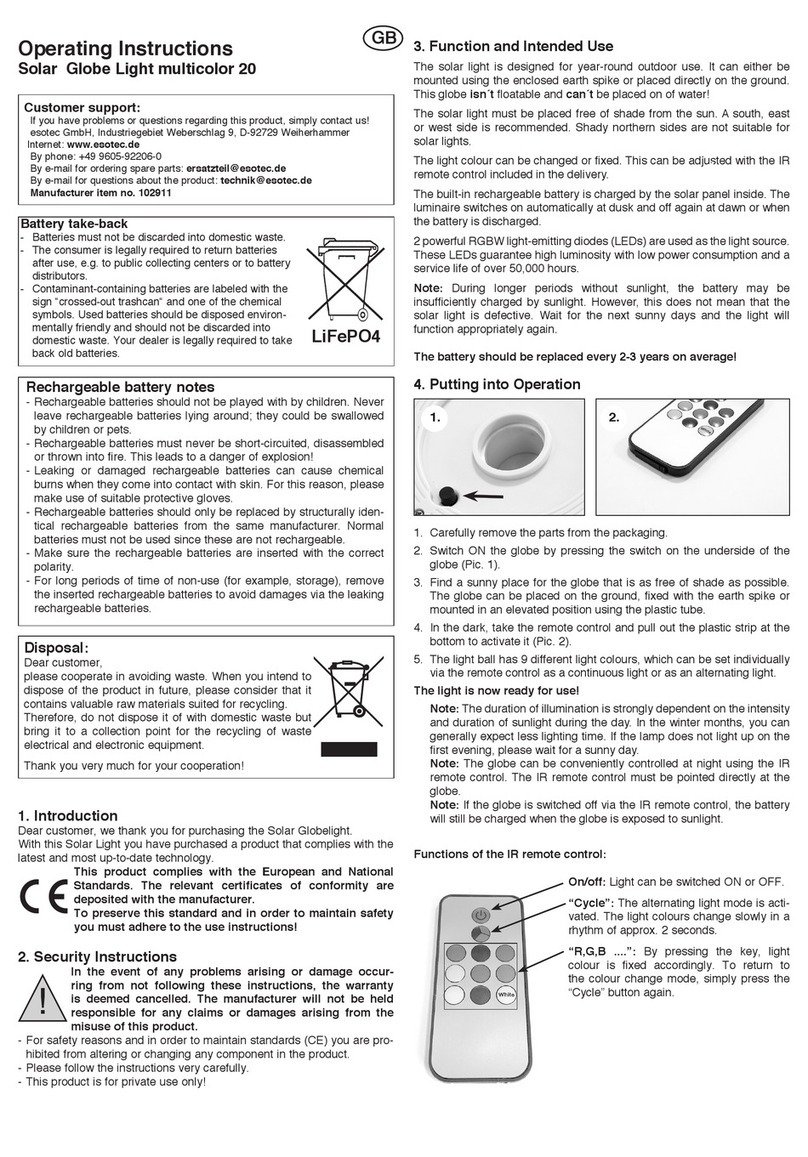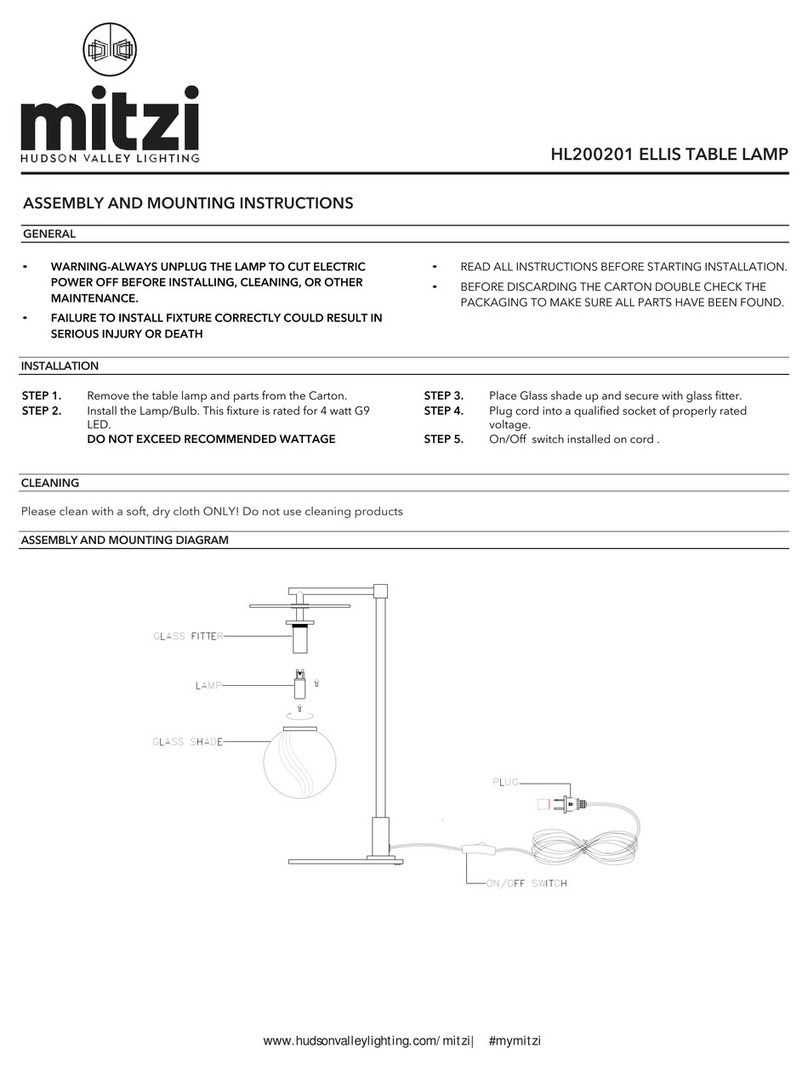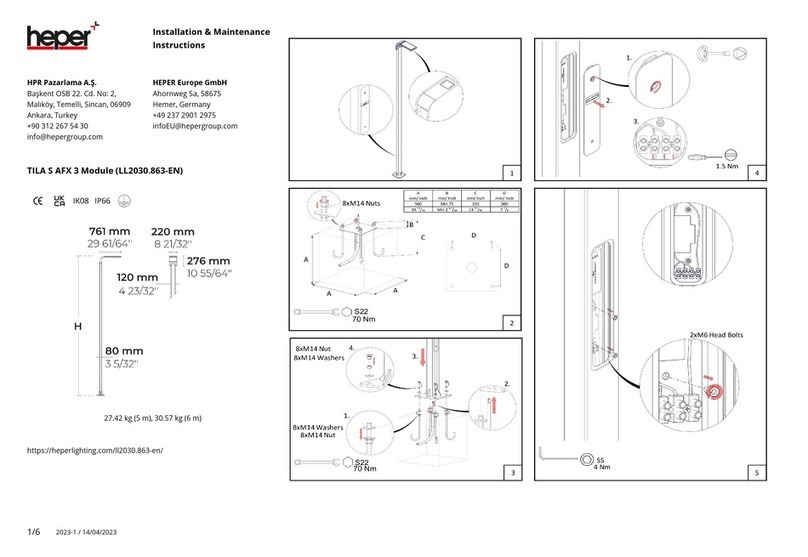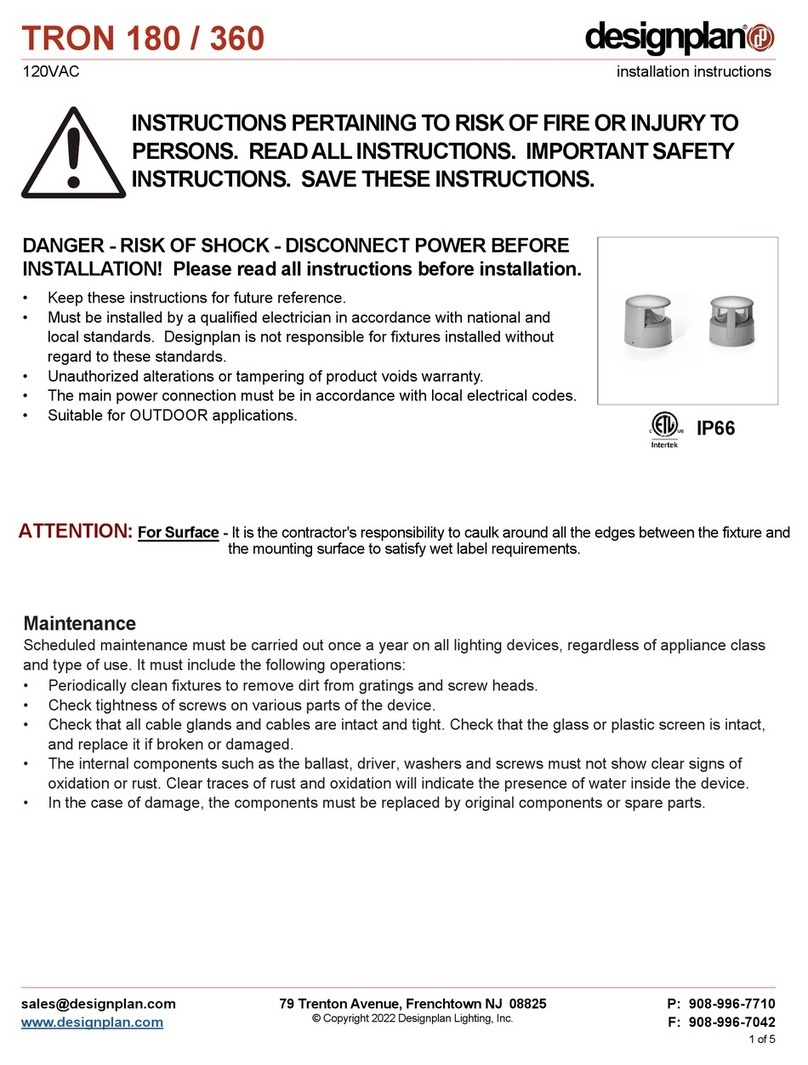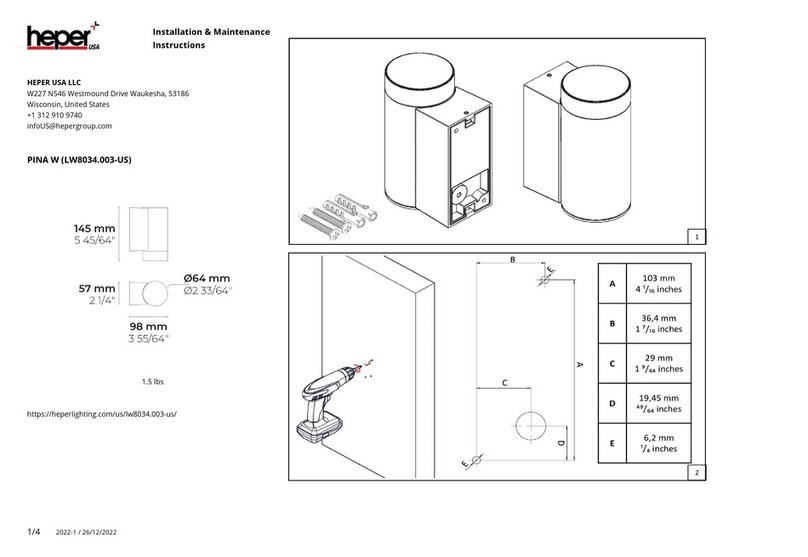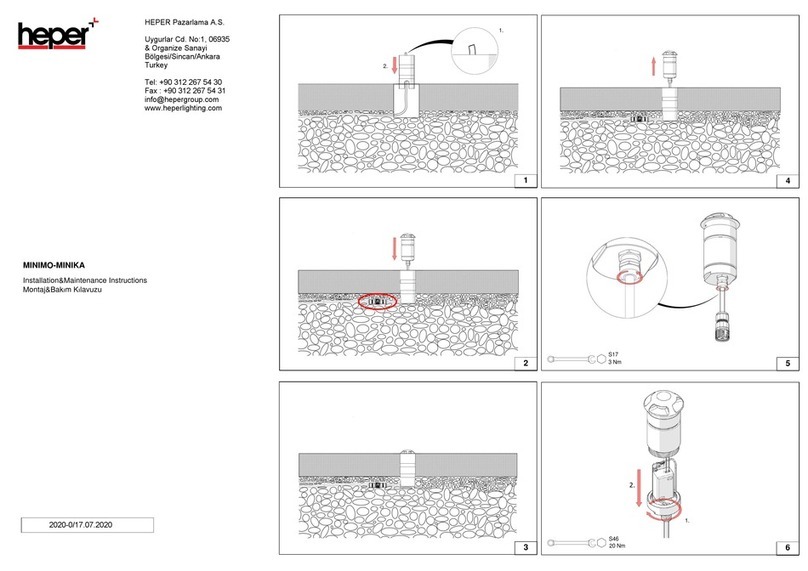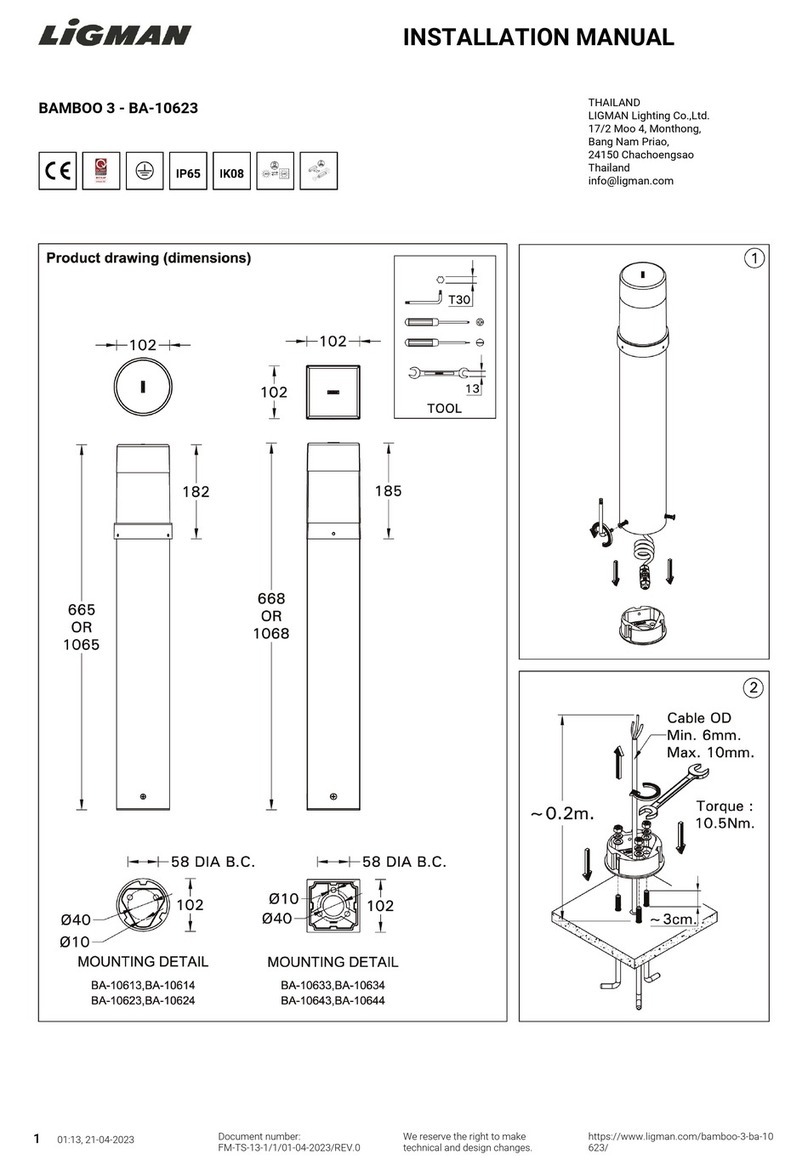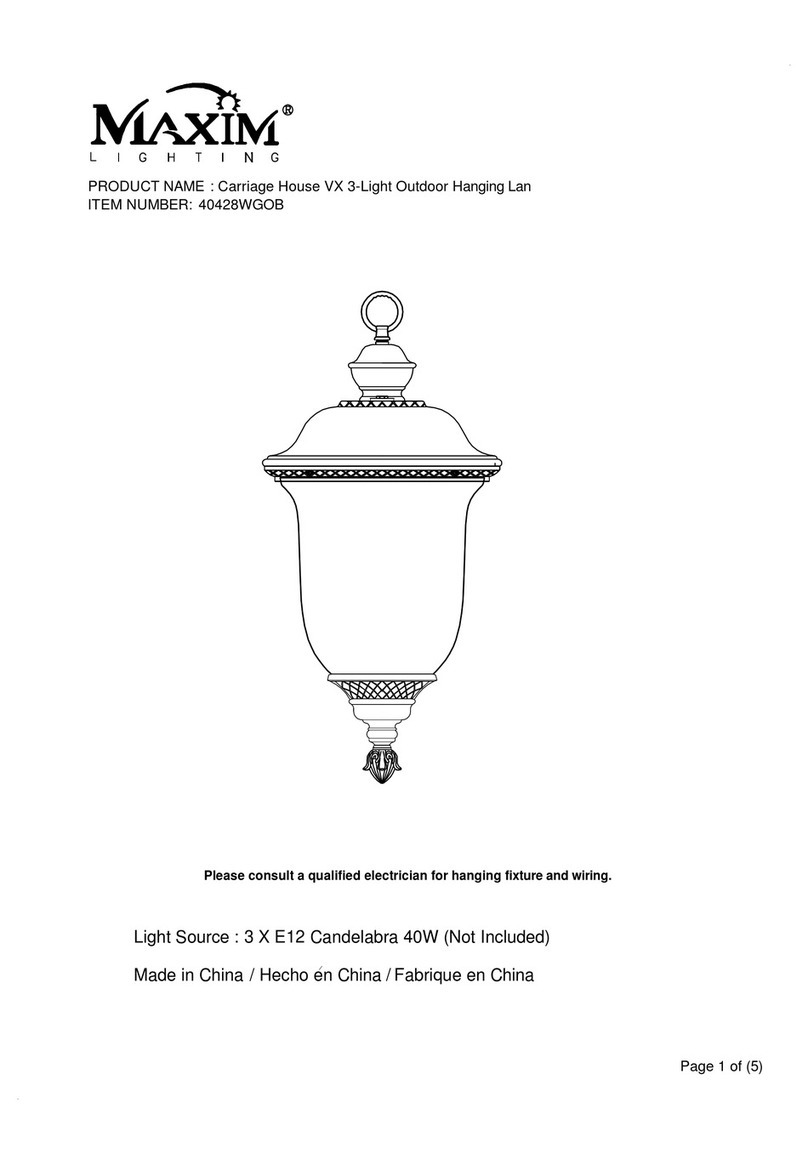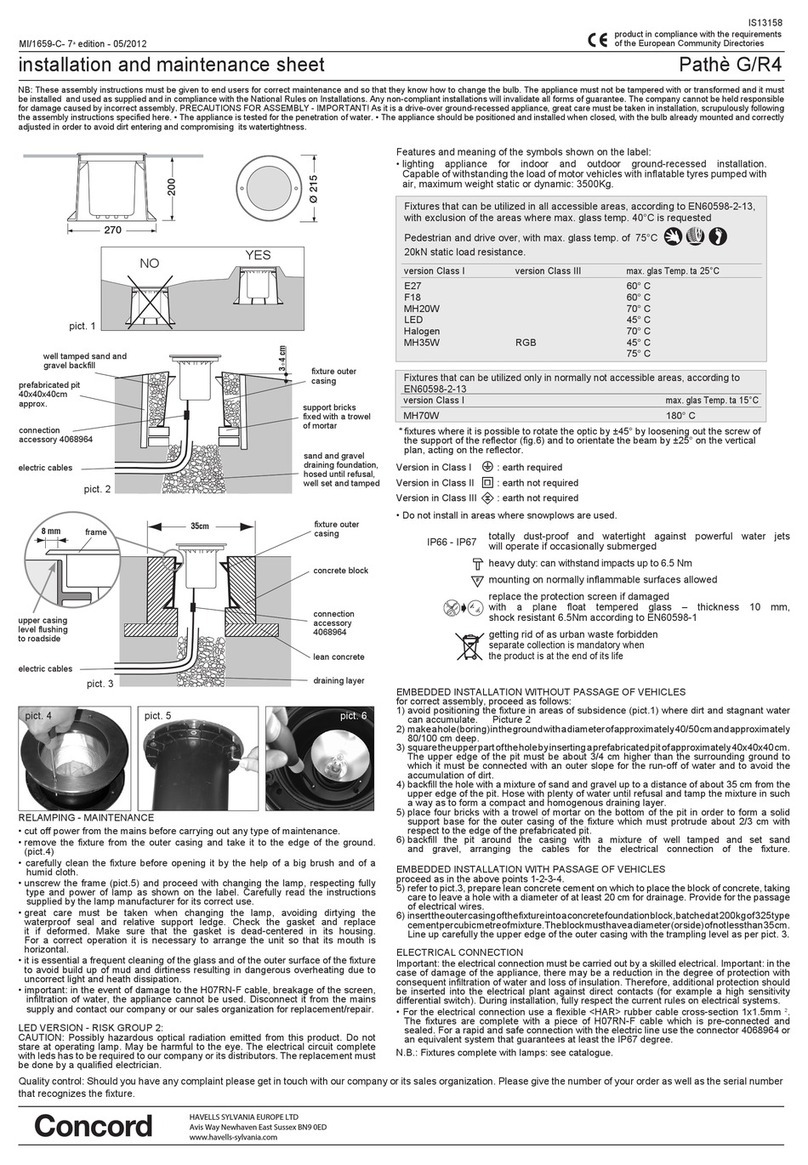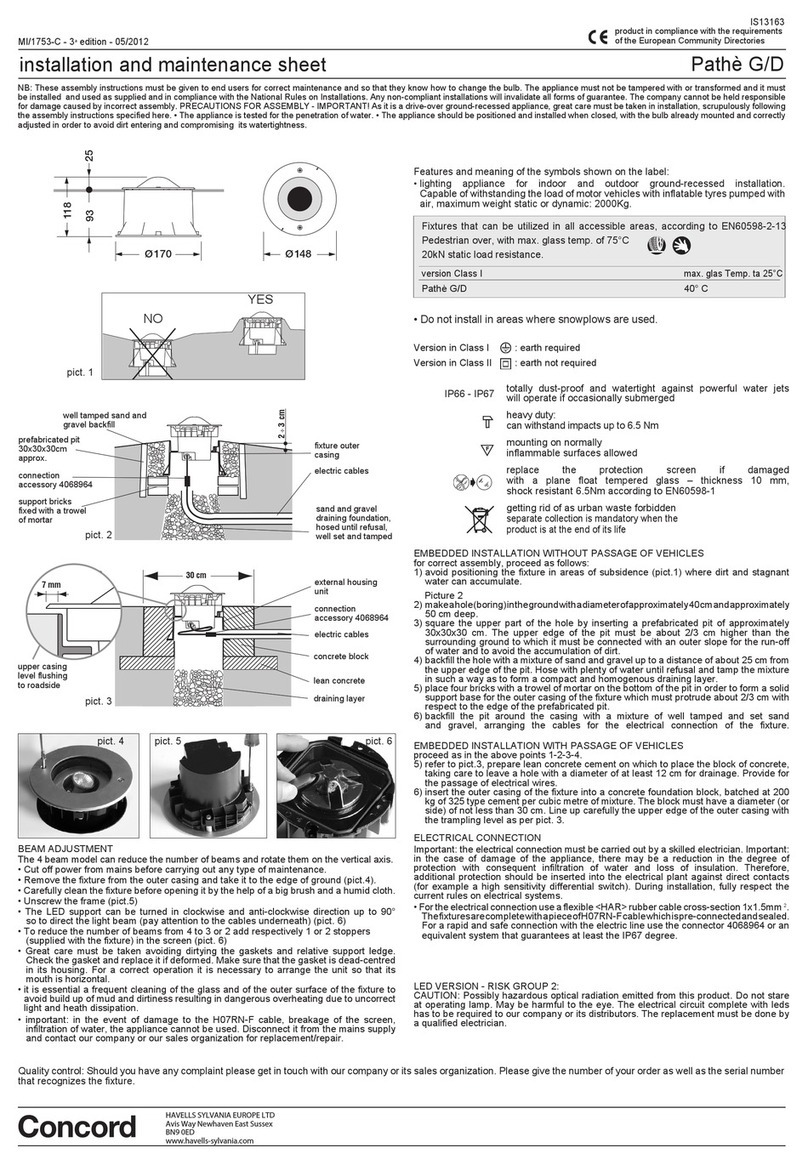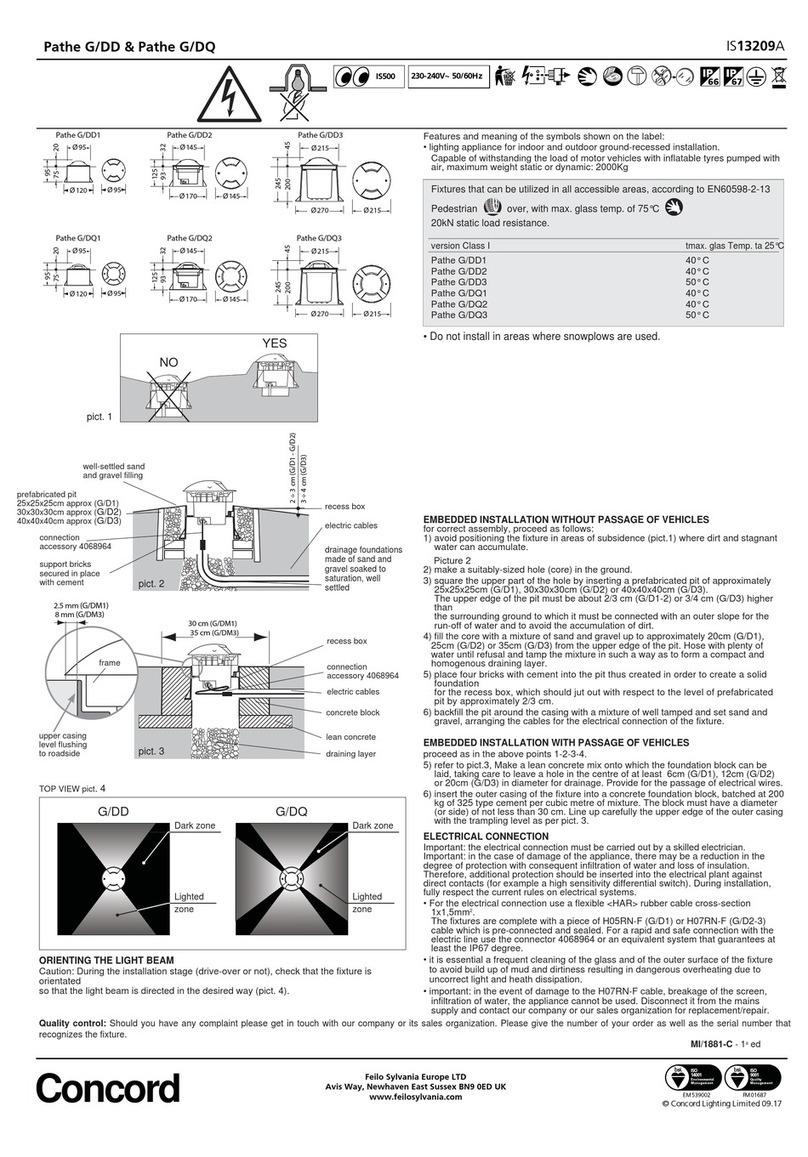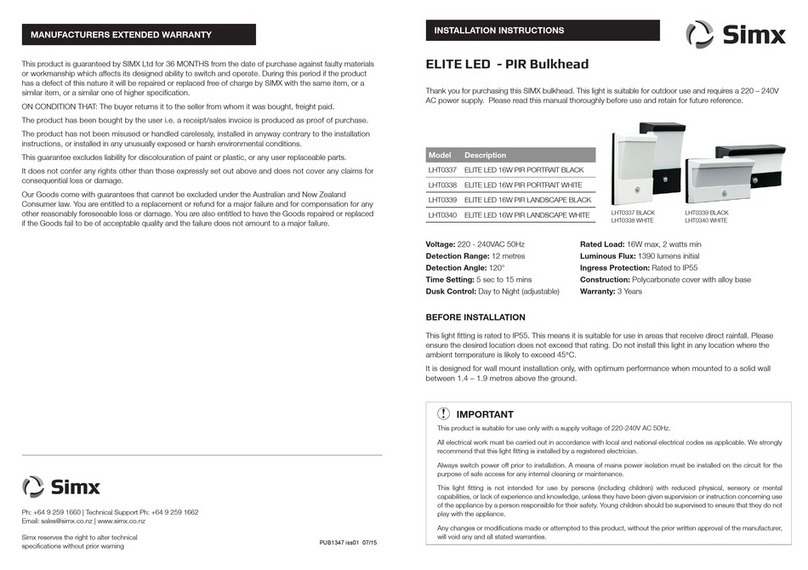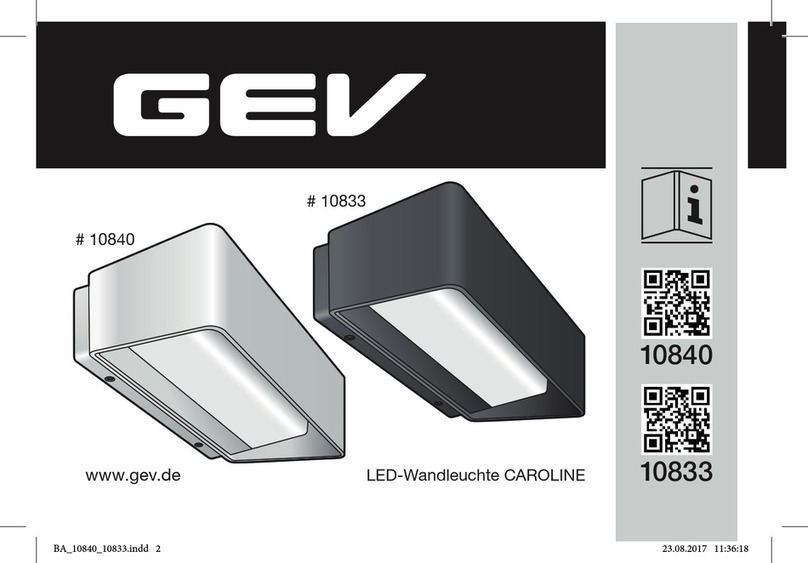
HAVELLS SYLVANIA EUROPE LTD
Avis Way Newhaven East Sussex BN9 0ED
www.havells-sylvania.com
AUSRICHTUNG DES LICHTBÜNDELS
• Vor allen Wartungsmaßnahmen muss die Spannungsversorgung abgeschaltet werden.
AUSBAU:
• Die Schrauben (1) aus Abb. 4 herausdrehen und die Leuchte aus dem Gehäuse ziehen.
• Die Leuchte mit einem großen Pinsel und einem feuchten Tuch vor dem Öffnen sorgfältig
säubern.
• Die Schrauben (2) aus Abb. 4 zum Öffnen der Leuchte herausdrehen.
VERSION G/DM1:
• Die Neigung des Lichtbündels einstellen (Abb. 5), die Linse nicht anfassen.
Das Lichtbündel kann auf eine Neigung zwischen 0° und 45° ausgerichtet werden.
VERSION G/DM3:
• Die 4 Schrauben (3) lockern und die LED durch Verschieben der Halterung auf den
Schienen wie in Abbildung 7 dargestellt einstellen. Das Lichtbündel kann auf eine Neigung
zwischen 0° und 45° ausgerichtet werden. Die Bezugsmarken geben 0°- 22° und 45° an.
ACHTUNG: PRÜFEN SIE, DASS SIE DIE SCHRAUBEN 3 (ABB. 6) NACH DER REGULIERUNG DES
LICHTBÜNDELS AUSREICHEND FESTGEZOGEN HABEN. WERDEN DIESE SCHRAUBEN NICHT
FESTGEZOGEN, KANN DIES IRREPARABLE SCHÄDEN AN DER LEUCHTE ZUR FOLGE HABEN, DIE
NICHT DURCH DIE GARANTIE ABGEDECKT SIND
.
WIEDEREINBAU:
• Nach Beendigung der Einstellungen genau prüfen, dass kein Schmutz oder Geröll an der
Dichtung oder ihrem Sitz vorhanden ist. Wenn die Dichtung defekt oder verformt ist, MUSS
sie durch eine neue ersetzt werden.
Pathe G/DM
Gut gesetzte Füllschicht
aus Sand und Kies
Gehäuse
Bis zur Sättigung
gewässerter
Drainagegrund aus
Sand und Kies, gut
gesetzt
Abb. 1
Mit Mörtel fixierte
Backsteine als Basis
Anschluss an
Zubehör 4068964
vorgefertigter
Einbauschacht
ca. 25x25x25cm (G/DM1)
ca. 40x40x40cm (G/DM3) Leitungskabeln
JA
NEIN
2÷3 cm
3÷4 cm
35 cm (G/DM3)
(G/DM1)
Montageanleitung - Instandhaltung
obener Faden des
Schachtels auf der
Strasseroberfläche nivelliert
Abb. 7
Abb. 4 Abb. 5 Abb. 6
Pathe G/DM1 Pathe G/DM3
200
245
45
Ø270 Ø245
Ø 215
95
Ø 95
Ø 120 Ø95
75 20
Qualitätskontrolle: Sollten Sie Reklamationen haben, wenden Sie sich an unsere Firma oder an unsere Verkaufsorganisation unter Angabe des Bestelldatums und der
Kennummer des Geräts.
Version in Klasse I : benötigt ein Erdungskabel
IP66 - IP67 Absolut staubdicht Schutz bei Untertauchen
und wasserdicht gegen stärke Wasserstrahle
Belastbarkeit: kann Stösse von einer Kraft bis 6,5 Nm ertragen
Geeignet für Montage auf normal entflammbaren
Befestigungsflächen
Den Schutzschirm bei Beschädigung austauschen.
Setzen Sie sich zum Erhalt eines Ersatzes mit unserem
Vertriebsnetz in Verbindung.
Das Entsorgen im Hausmüll ist verboten!
Bei Ablauf der Lebensdauer bitte beachten:
Abfalltrennung ist Pflicht
MONTAGE UNTER DER ERDE, NICHT BEFAHRBAR
für eine richtige Montage, muss wie folgt vorgegangen werden:
1) d
as Gerät nicht in Senkungen installieren (Abb.1), in denen sich lecht Schmutz und Feuchtigkeit
ansammeln kann.
Abbildung 2
2) Ein Loch (Kernbohrung) geeigneter Größe im Boden vorsehen.
3) Den oberen Teil des Loches mit einer vorgefertigten Verschalung mit einem Ausmass von
25x25x25cm (G/DM1) bzw. 40x40x40cm (G/DM3) verstärken. Der obere Rand der
Verschalung muss
ca. 2/3 cm (G/DM1) bzw. 3/4 cm (G/DM3) aus dem Boden herausragen und abfallende
Flanken nach aussen haben, um das Abfliessen des Wassers zu erleichtern und das
Ansammeln von Schmutz zu vermeiden.
4) Das Loch mit einem Gemisch aus Sand und Kies bis zu einem Abstand von etwa 20
cm (G/DM1) bzw. 35 cm (G/DM3) vom oberen Schachtrand füllen. Reichlich mit Wasser
begiessen, damit sich die
Mischung richtig festsetzt und eine wasserdurchlässige kompakte und gleichmässige
Schicht bildet.
5) Auf dem so erhaltenen Boden des Einbauschachtes vier Backsteine mit Mörtel so fixieren,
dass eine feste Basis für das Gehäuse entsteht, das etwa 2/3 cm über den Rand des
vorgefertigten Einbauschachtes überstehen muss.
6)
Das Loch um das Chassis herum mit einer Mischung aus Sand und Kies ausfüllen, die gut
festgedrückt werden muss, wobei gleichzeitig die Linienkabel des Gerätes für die elektrische
Verbindung ausgerichtet werden müssen.
MONTAGE UNTER DER ERDE, BEFAHRBAR
Die Anweisungen 1-2-3-4 wie oben angegeben befolgen
5) vgl. Abbildung 3, Eine Magerbetonschicht einbringen, auf welcher der Fundamentblock
aufgesetzt wird; dabei darauf achten, dass in der Mitte ein Loch mit einem Durchmesser
von mindestens 6 cm (G/DM1) bzw. 20 cm (G/DM3) für die Drainage gelassen wird. Ein
Durchgang für die Kabeln vorsehen.
6)
Das Chassis des Gerätes in einen Zementboden einlassen, der auf 200 Kg Zement des Typs
325 pro Kubikmeter Mischung bemessen ist.
Der Zementblock muss einen Durchmesser
(oder eine Seite) von mindestens 30 cm haben.
Der obener Rand des aussenes Schachtels
mit der Fußgängeroberflache aufmerksam anpassen.
(Abb.3)
ELEKTROANSCHLUSS
Achtung: die elektrische Verbindung muss von einem qualifizierten Installateur durchgeführt
werden. Achtung: bei Beschädigung der Leuchte kann der Schutzgrad beeinträchtigt
werden mit daraus folgendem Eindringen von Wasser und Isolierungsverlust. Es wird daher
empfohlen, die elektrische Anlage mit einem Zusatzschutz gegen direkte Kontakte (z. B. mit
einem hochempfindlichen Differentialschalter) auszurüsten. Bei der Installation die geltenden
anlagentechnischen Vorschriften unbedingt befolgen.
•
Für die elektrische Verbindung ein flexibles <HAR> Gummikabel mit Querschnitt von 1x1,5mm
2
benützen. Die Geräte sind mit einem Stück H05RN-F (P01) bzw. H07RN-F (P2) Kabel
ausgestattet, der schon verbunden und getestet ist. Für eine schnelle und sichere Verbindung
an der elektrischen Leitung die 4068964 Anschlussstelle oder eine ähnliche verwenden die
einen Grad von mindestens IP67 gewährleistet.
• Das Glas der Leuchte sowie alle Aussenflächen des Gerätes müssen regelmässig
gereinigt werden, so dass Ablagerungen von Schmutz ausgeschlossen sind. Solche
Ablagerungen beinhalten die Gefahr einer Überhitzung und verhindern die Vorschriftsmässige
Lichtabstrahlung und Wärmedissipation.
• Achtung: im Fall von beschädigtem Kabel H07RN-F, Bruch des Schutzschirmes oder
Eindringen von Wasser darf die Leuchte nicht verwendet werden. Schalten Sie die Leuchte
vom Strom ab und kontaktieren Sie unser Unternehmen oder unsere Verkaufsorganisation
für den Austausch oder die Reparatur.
version Klasse I
Pathe G/DM1
Pathe G/DM3
max. Glastemperatur ta
25°C
40° C
50° C
Apparate die in allen zugänglichen Arealen verwendet werden können außer,
nach EN60598-2-13,
Begeh mit max. Glastemperatur 75°C Statische Belastbarkeit 20 kN.
• Nicht in Arealen installieren wo Schneeräumer eingesetzt werden.
Eigenschaften - Bedeutung der Symbole auf dem Typenschild:
• Begehbare Bodeneinbauleuchte für den Innen-und Außenbereich.
Hält das Gewicht von Kraftfahrzeugen mit Gummireifen aufgepumpt mit Luft,
aus maximalen Gewicht statisches oder dynamisches: 2000Kg
Betonblock
Magerschicht
dränierende Schicht
Gehäuse
Anschluss an
Zubehör 4068964
Leitungskabeln
Das Produkt entspricht den Richtlinien
der Europäischen Gemeinschaft
NOTA BENE: Vorliegende Montageanleitungen müssen auf jeden Fall dem Endverbraucher übergeben werden, damit dieser über die korrekten Wartungs- und Lampenaustauschmodalitäten
informiert ist. Jegliches Aufbrechen und/oder Änderung der Leuchte ist verboten. Die Leuchte muss wie geliefert und entsprechend den anlagentechnischen Landesvorschriften montiert und verwendet
werden. Nichtentsprechende Installationen führen zum Verfall von jeglicher Garantie. Das Unternehmen übernimmt keine Verantwortung für Schäden, die durch fehlerhafte Montage verursacht sind.
VORSICHTSMAßNAHMEN FÜR DIE MONTAGE - HINWEISE Da die Leuchte befahrbar und in den Boden eingelassen ist, muss die Montage mit größter Sorgfalt unter strenger Befolgung der hier
erwähnten Montageanleitungen durchgeführt werden. • Die Leuchte ist auf Wassereindringung getestet und geprüft. • Es empfiehlt sich, die Leuchte geschlossen mit bereits montierter Lampe und korrekter
Ausrichtung zu positionieren und zu installieren, um den Eintritt von Schmutz zu vermeiden und die Dichtigkeit nicht zu beeinträchtigen.
8 mm (G/DM3)
2.5 mm (G/DM1)
Rahmen
Abb. 2
Abb.3
13
ACHTUNG
ANFASSEN SIE
DIE LINSE NICHT
2


